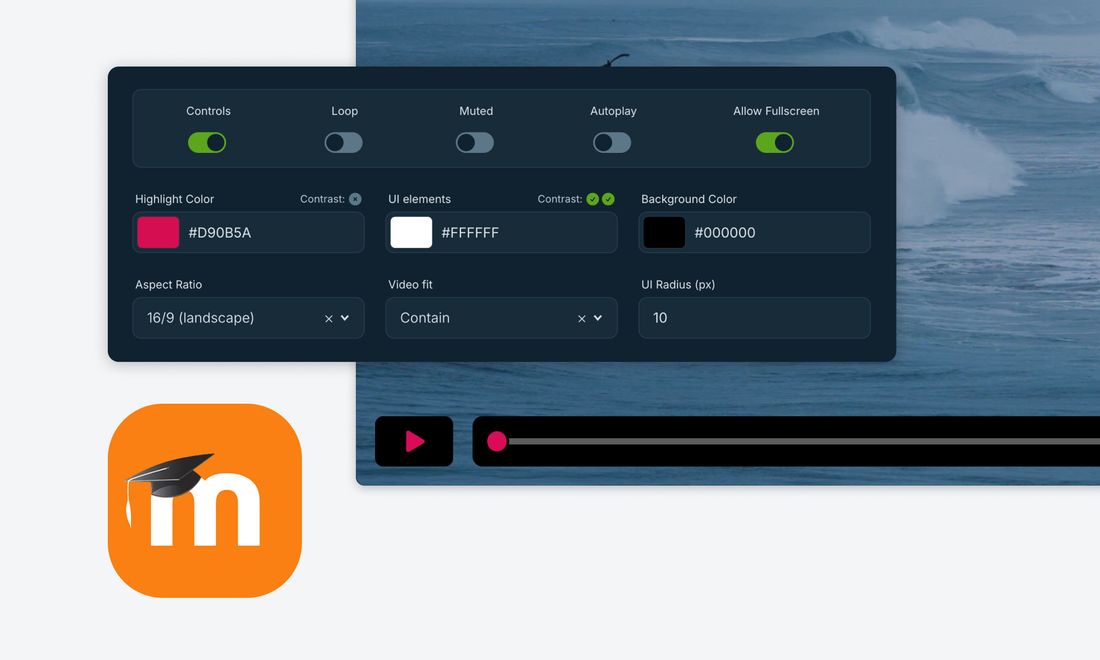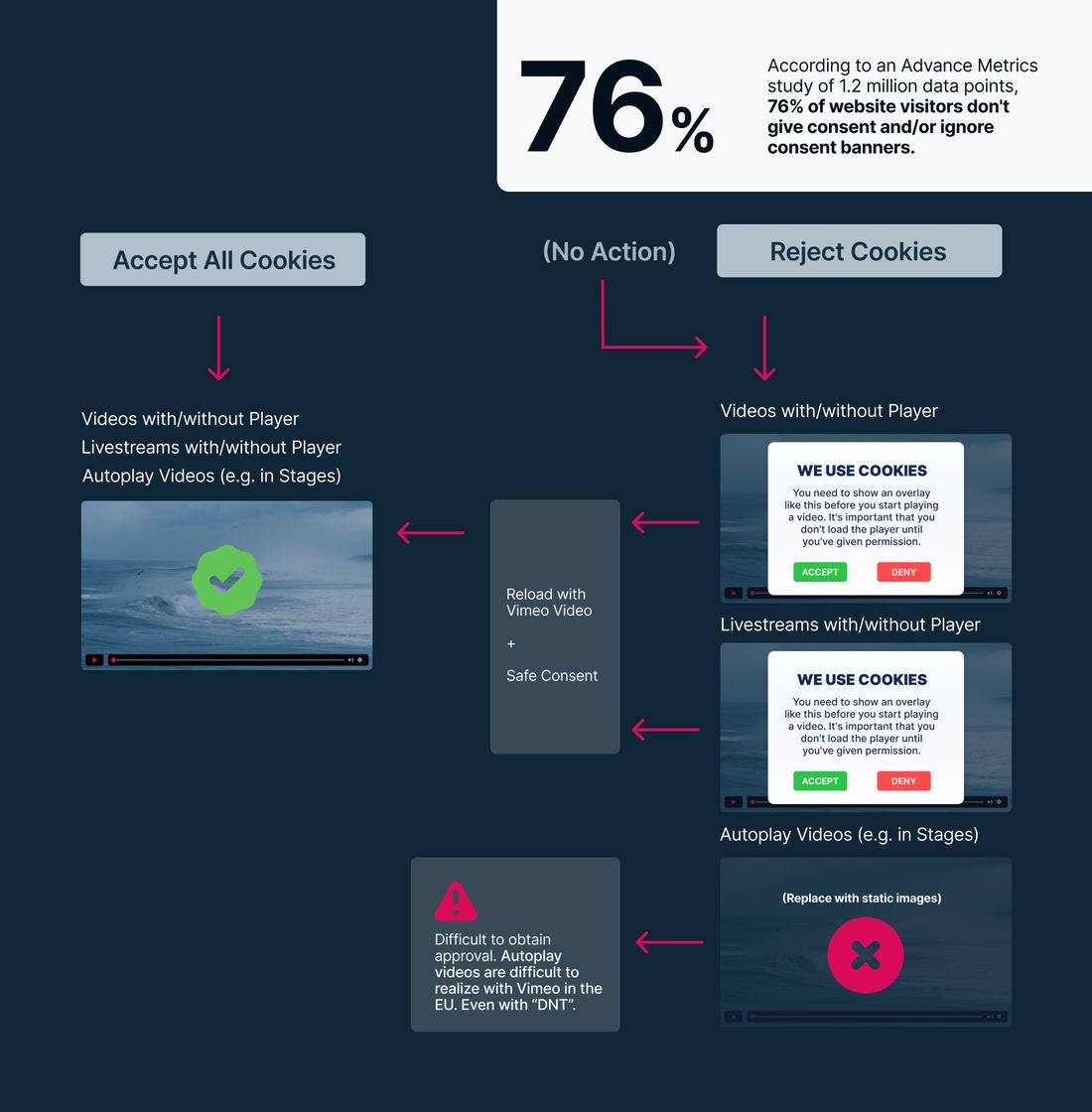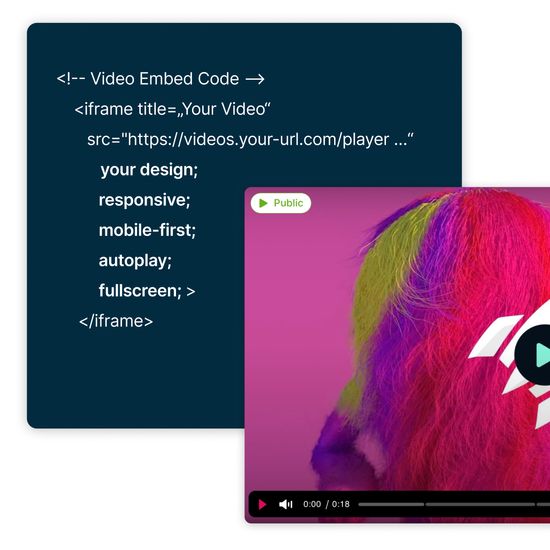
Embedding Videos in Moodle: What You Need to Know
Moodle is one of the world’s most popular learning management systems – especially in education, public institutions, and NGOs. It’s powerful, flexible, and open source. But when it comes to embedding videos, things can get technical – and often frustrating.
👉 In this article, you'll learn:
- What options you have for embedding videos in Moodle courses
- Why uploading videos directly to Moodle isn’t the best idea
- Which technical and legal pitfalls exist when using platforms like YouTube or Vimeo
- And how to embed videos securely and GDPR-compliantly – with tools like Ignite Video
I’ll try not to get too technical – but there are a few places where it’s hard to avoid. Sorry in advance!
What options are there for embedding videos in Moodle?
Let’s start with the basics: Moodle offers several ways to add content to your courses – including video. Here’s a quick overview of the most common methods:
1. Uploading videos directly to Moodle
You can upload video files directly into course content – for example in a text block, a label, or using the file upload feature. Moodle then uses its built-in player to display the video.
Sounds easy? It is – but only at first glance.
Video files are large, the player is limited, and performance often suffers when multiple students stream videos at the same time. Backups also get bloated with heavy media files.
2. Embedding from platforms like YouTube or Vimeo
"When server space or upload limits are restricted, or if you are seeking some video player features not available within Moodle, it is convenient to upload videos to an online site like YouTube or Vimeo." – Moodle Docs
This is the classic method: upload your video to YouTube or Vimeo, copy the embed code, and paste it into Moodle.
It’s fast – but legally tricky if you care about privacy compliance.
Also: your files are now stored in the US. For many Moodle users in Europe, that’s simply not acceptable.
3. Self-hosting with your own video player
This approach gives you full control. You host the videos on your own server and use an HTML5 player like Plyr or Video.js to embed them.
That works well – but it requires technical know-how, maintenance, and server capacity.
4. GDPR-compliant platforms like Ignite Video
Clean, simple, and privacy-first: tools like Ignite Video offer professional video hosting, easy HTML embedding, and full control over data protection and domain restrictions.
A great choice for schools, public sector Moodle installs, or any organization with high privacy standards.
Why uploading videos directly to Moodle isn’t a good idea
Many users start with the easiest option – uploading a video directly into Moodle.
But in practice, that’s rarely the right solution.
1. Storage issues
Video files are huge. Moodle servers – especially on shared hosting – can quickly run out of space, especially when multiple users stream media-heavy courses.
"...if your file is too large to upload directly to Moodle, you will need to ‘host’ it elsewhere ..." - tutorial.bilkent.edu.tr
Because of this, many Moodle installations place strict limits on upload size.
2. No adaptive streaming
Moodle’s default player doesn’t support adaptive streaming. That means users on slow connections or mobile devices can’t load a lower-quality version – they’re forced to download the full high-quality file.
Example: if your video course is 60 minutes long, you’re quickly looking at 1–2 GB file sizes. Without adaptive streaming, every user has to load that entire file in full.
(For more on this: see HLS Streaming)
3. Server load & bloated backups
Video content doesn’t just slow down page load – it also increases server load and makes course backups unnecessarily large. This can lead to problems when restoring or cloning courses.
The better solution: External hosting + embedding via embed code
"...benefits of a real streaming provider are plentiful: Datacenters around the world for great performance … Automatic selection of the right video version for the user (depending on bandwidth, browser support, CPU performance etc.)." Moodle Community Wiki
Instead of serving large video files from your Moodle server, you can host them externally and embed them using an HTML code snippet.
The benefits:
- Adaptive streaming (quality adjusts automatically to device and bandwidth)
- Lower load on your Moodle server
- Central video management – one update affects all locations
- Smaller backups
- Technically easy – copy & paste is all it takes
That’s why this approach is the go-to solution for many. But not all providers are created equal…

Why YouTube & Vimeo aren’t ideal for Moodle
YouTube and Vimeo are widely used – but often the wrong fit for professional Moodle setups.
❌ Privacy & data protection
Both platforms set cookies, transfer data to the US, and typically require consent banners – a legal headache, especially for schools or public sector use.
“Since embedding Vimeo is not essential for the operation of the website, it requires user consent under GDPR. Embedding can only be based on user consent, as other legal bases are not suitable.
Because using Vimeo potentially involves transferring data to a third country without an adequacy decision, processing requires user consent under Article 49(1)(a) GDPR. Users must be clearly informed about the risks of such data transfers so they can make an informed decision.
A data processing agreement under Article 26 GDPR must also be concluded with Vimeo Inc. The key contents of that agreement must be made available to data subjects – including who to contact for exercising data rights.” – Legalweb.io (Translated from German)
❌ Loss of control over content & branding
YouTube shows ads and suggested videos. Vimeo blocks ads, but still requires cookie consent and doesn’t offer full control over privacy or regional hosting.
❌ No real EU hosting guarantee
As US companies, YouTube and Vimeo are subject to the CLOUD Act – which undermines true data sovereignty in the EU.
If you need legal certainty, choose a European platform like Ignite Video.
Why Ignite Video is the better choice for Moodle
Ignite Video was built specifically with privacy-sensitive use cases in mind – including education, government, and EU-based organizations using Moodle. While many providers offer “video hosting,” few deliver the combination of data protection, reliability, and ease of integration that Moodle users really need.
Here’s what sets Ignite apart:
GDPR-compliant and completely cookie-free
Unlike platforms that rely on third-party tracking or embedded analytics scripts, Ignite delivers your videos without setting a single cookie. No banners, no popups, no tricky opt-ins – your users can just press play and focus on the content.
You don’t need to worry about user consent, nor about hidden data flows to advertising networks or foreign vendors. It’s video hosting that respects your audience’s privacy – by default.
Hosted entirely in the EU
Ignite stores and delivers all video content from servers located in the European Union. That means no data transfer to third countries, no dependency on US cloud providers, and full alignment with the legal requirements of the GDPR and the rulings of the European Court of Justice (like Schrems II).
If your institution has strict compliance rules, Ignite is the safe choice.
No plugins, no headaches
Embedding a video from Ignite into Moodle is incredibly simple. There’s no need for plugins, API integrations, or custom development. Just copy the embed code from your Ignite dashboard and paste it into Moodle’s HTML editor. That’s it.
The player is fully responsive, accessible, and works across all devices – without extra configuration.
No file size limitations
Whether you’re uploading short clips or full-length lectures: Ignite handles it. You can upload files that are 5 MB or 50 GB – the infrastructure is designed to scale. There’s no need to compress your videos beforehand or worry about server quotas.
Total control over video delivery
Ignite gives you full flexibility. You can configure domain restrictions (so your video only plays on authorized Moodle sites), choose player options, define poster images, control autoplay behavior, and more.
You also get powerful stats – and the confidence that no one but you is collecting user data.

How to embed Ignite Video in Moodle – a quick guide
Adding Ignite videos to Moodle is easy, clean, and privacy-compliant. Here’s how it works:
Step 1: Upload your video to Ignite
- Log in to your Ignite dashboard
- Upload your video via drag & drop or the upload button
- Add metadata (title, description, subtitles, chapter markers)
- Ignite automatically transcodes the video for streaming
Tip: Add subtitles, chapters, and preview images for better accessibility and learning value. Ingite can create these Subtitels with AI for you.
🔒 Optional: Protect your videos
All Ignite videos are protected against simple downloads by default.
For added security, you can restrict playback to specific domains.
Step 2: Generate the embed code
- Open the video detail view
- Select “Embed”
- Adjust settings (player size, aspect ratio, autoplay, responsiveness, etc.)
- Copy the embed code
Step 3: Paste the code into Moodle
- Open your Moodle course and turn editing on
- Add a new element (text block, label, or page)
- Open the HTML view (<>)
- Paste the embed code
- Save – and you’re done!
Additional tips:
- Works in forums, quizzes, and blocks too
- No plugin required
- Choose strong preview images – the thumbnail sets the tone
- Organize videos by course module for clarity
Want to use a plugin?
If you prefer working with a Moodle plugin, VideoTime is a popular option. It supports HLS streaming, which is precisely what Ignite provides.
In the Ignite dashboard, go to “Files” and look for the .m3u8 file – that’s your HLS stream URL. You can copy and paste it directly into VideoTime for smooth integration, with full control over playback and visuals.
Note: You can also test the direct HLS link in other Moodle elements – it works in many contexts without plugins.
That said, VideoTime itself promotes Vimeo – which, as mentioned above, we wouldn’t recommend due to privacy concerns.
Final thoughts: Moodle + video done right
Video belongs in digital learning – and Moodle supports it. But how you integrate video makes a big difference:
❌ Direct upload → performance issues & storage problems
❌ YouTube/Vimeo → privacy and legal concerns
✅ External hosting with Ignite → GDPR-compliant, performant, and easy to embed
Sounds interesting?
Then you can try all Ignite features for 30 days completely free of charge. No up front subscription, no need for payment details. Of course, we can also schedule a personal demo to show you what's possible with Ignite.


